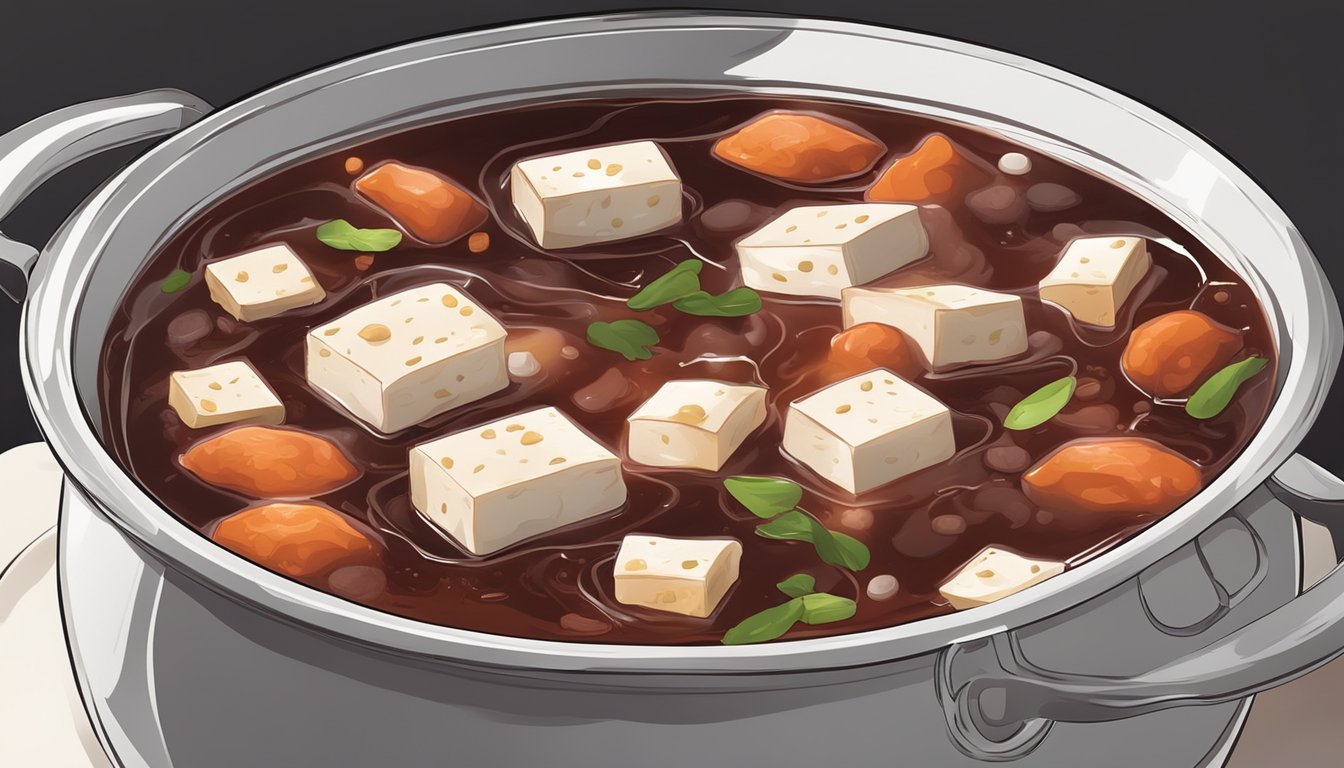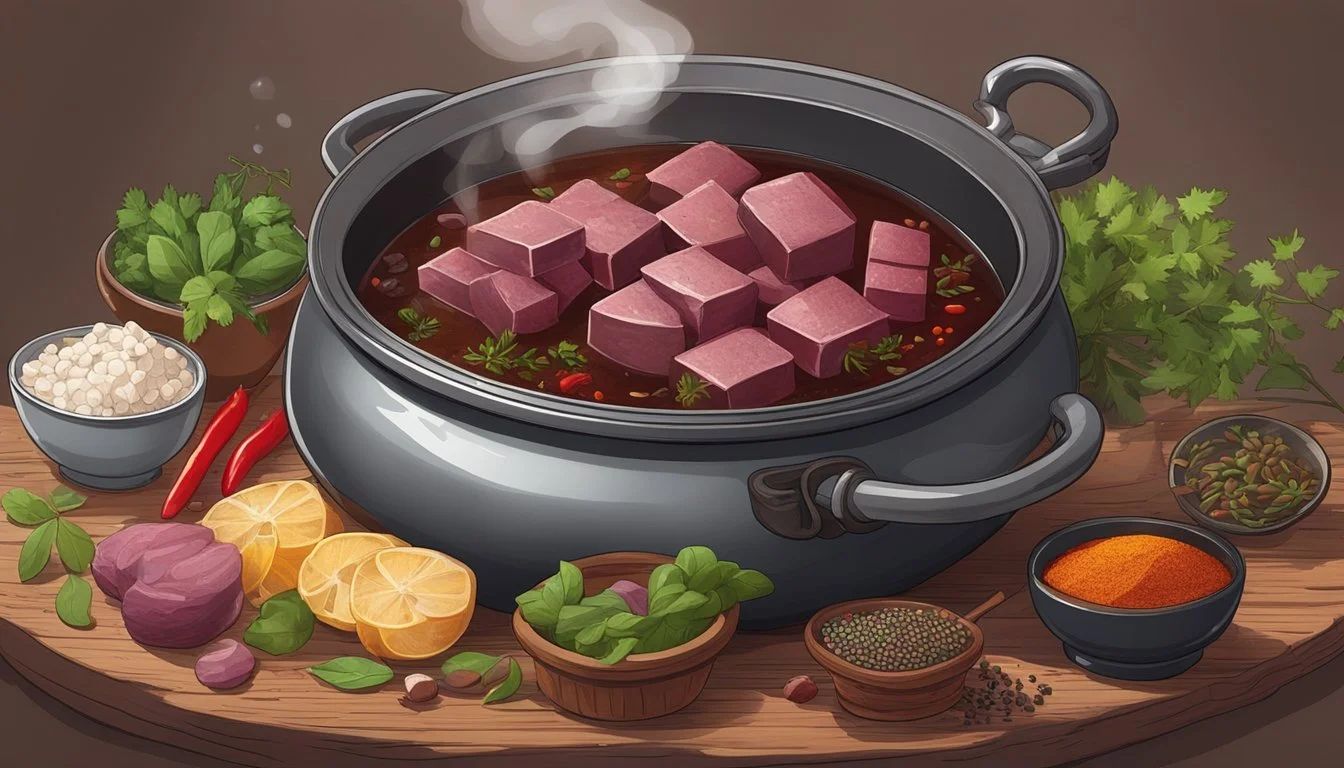Blood Tofu
Exploring the Savory Asian Delicacy Derived from Duck and Pig Blood
Blood tofu, also known as blood pudding or blood cake, is a savory item rich in history and flavor. Originating from Asia, particularly known in Chinese cuisine, this delicacy is made by coagulating the blood of ducks (What wine goes well with duck?) or pigs and then steaming or boiling it until it takes on a tofu-like consistency. The cultural significance of blood tofu can be traced back through the culinary traditions of various Asian countries, where it remains a staple in both daily meals and festive occasions. Its presence on the table speaks to a deep-rooted respect for using all parts of an animal, reflecting a philosophy of minimal waste in cooking practices.
Nutritionally, blood tofu is a powerhouse, being high in protein and rich in minerals, such as iron and zinc. It's often combined with starches like noodles or rice in a meal, providing a balanced diet. Its versatility allows it to be served in various dishes, from soups to stir-fries, highlighting different regional tastes and preferences. The texture of blood tofu is smooth and slightly jelly-like, making it a unique addition to dishes, providing a contrast to other ingredients used in Asian cuisines.
The preparation of blood tofu involves meticulous traditional methods to ensure the right texture and safety for consumption. It is essential in dishes like the Chinese pig blood curd, often paired with carbohydrates such as noodles or congee, and the duck blood and vermicelli soup, a specialty of Nanjing known globally for its rich duck dishes. While the idea of consuming blood-based products may be unfamiliar or even off-putting to some, blood tofu is a delicacy that resonates with many across Asia for its cultural authenticity and nutritional benefits.
Historical Context of Blood Tofu
Blood tofu has been an integral component of traditional Chinese cuisine for centuries, with regional variations that have contributed to its cultural significance across Asia. It has since moved beyond its native borders to reach global audiences, adapting to new cultures and tastes.
Blood Tofu in Traditional Chinese Cuisine
In China, blood tofu is known as 豬紅 (zhū hóng) or 血豆腐 (xuè dòufu), with its origins deeply rooted in culinary traditions. It is made from coagulated pig or duck blood, resembling tofu in texture, and often incorporated into hearty dishes that complement its rich flavor. This delicacy is commonly found in Sichuan and Southern China, where it is typically served with staple carbohydrates like noodles or congee.
Sichuan: Popular in spicy hot pots.
Southern China: Served in stews or with congee.
Cultural Significance and Variations
Blood tofu carries cultural significance that varies from region to region within China and has also found a place in other Asian cuisines like those of Taiwan and Vietnam. In Taiwan, it is included in the local version of hot pot, while in Vietnam, it appears in specific regional dishes. The preparation and celebration of blood tofu are often rooted in family traditions and local festivities, highlighting its importance beyond a simple dish.
Taiwan: Added to hot pots.
Vietnam: Used in regional recipes.
Global Spread and Perception
The expansion of blood tofu to Western countries has been met with a mix of curiosity and hesitation. Its distinct origin and flavor profile present it as an exotic delicacy to Western palates. There's an increasing openness to exploring traditional Asian dishes, including blood tofu, which is often introduced in authentic Asian restaurants or through the growing popularity of international cuisine.
Western Countries: Experiencing varied levels of acceptance and integration into local food scenes.
Through these regions, blood tofu showcases the rich tapestry of Asian culinary history and its continuous influence on global gastronomy.
Blood Tofu Production
Blood tofu, also known as blood curd, is a specialty food notably produced from duck or pig blood. This product undergoes a delicate process to transform raw blood into a consumable food item.
Sourcing and Selection of Animal Blood
Duck blood and pig blood are the primary sources for producing blood tofu. The quality of the final product is heavily dependent on the freshness of the blood. Typically, blood is collected during the slaughtering process under stringent sanitary conditions to ensure safety and quality. It is crucial that the blood is immediately stored at proper temperatures to prevent spoilage and coagulation before it is processed.
Coagulation and Shaping Process
To make blood curd, the raw blood must first coagulate. This is accomplished by adding a coagulant, which can vary between producers, but common choices include salt and vinegar. Once the blood begins to thicken, the mixture is transferred into molds to shape the curd. It's vital that this process is controlled meticulously to avoid any improper texture or coagulation levels.
Steaming Versus Boiling Techniques
The steaming and boiling techniques are two methods employed to cook blood curd.
Steaming: This method involves cooking the curd at high temperatures using steam. This technique is preferred for maintaining a tender texture while fully cooking the curd. The timing is essential in this method to ensure that the blood tofu is cooked evenly throughout.
Boiling: Alternatively, the curd may be gently boiled. This method is especially popular for pig blood curd. Boiling usually has a specified duration to achieve the desired firmness and to ensure that the blood is safe for consumption.
Both techniques are critical in affecting the flavor, texture, and overall quality of the blood tofu. After cooking, the blood tofu can be consumed on its own or incorporated into various dishes.
Nutritional Profile of Blood Tofu
Blood tofu is a nutrient-rich food that provides a range of proteins, vitamins, and minerals essential to the human diet. It is particularly known for its high iron content and complete amino acid profile.
Protein and Amino Acid Content
Blood tofu is a good source of protein, essential for muscle repair and growth. It contains all nine essential amino acids, making it a complete protein source. The specific amount of protein varies based on the type of blood tofu, with pig blood curd generally offering between 15-20 grams of protein per 100 grams.
Vitamins and Mineral Composition
Rich in iron, blood tofu can contribute significantly to the recommended daily intake for adults, which is especially beneficial for individuals at risk of iron deficiency. Each serving contains a substantial amount of minerals such as calcium and phosphorus, which are vital for bone health.
Notable vitamins found in blood tofu include:
Vitamin C: Enhances iron absorption.
Niacin: Supports metabolism and skin health.
Riboflavin: Aids in energy production.
Dietary Considerations and Health Impacts
While blood tofu is valuable for its iron and proteins, it's also higher in cholesterol compared to other vegetarian protein sources. Individuals monitoring their cholesterol intake should consume it in moderation. In terms of lecithin content, blood tofu provides this beneficial fat, which can support brain function and nerve health. However, excessive iron intake can lead to iron poisoning, though this is generally rare and would require consuming large amounts of blood tofu.
Blood tofu fits into a balanced diet and offers a rich profile of nutrients despite its potential high cholesterol content. Those looking to boost their iron intake may find it particularly beneficial, though as with all foods, it should be consumed in moderation as part of a varied diet.
Culinary Uses of Blood Tofu
Blood Tofu is an ingredient with deep roots in Asian cuisine. It is used in a variety of dishes ranging from traditional soups to innovative modern recipes, contributing rich flavors and nutrients.
Traditional Dishes Featuring Blood Tofu
Soups: Blood tofu is a key ingredient in several Asian soups like the Duck Blood and Vermicelli Soup, which is a traditional delicacy in Nanjing, China. The soup combines duck blood tofu with vermicelli, duck liver, and various aromatic spices.
Hot Pot: Blood tofu can also be found simmering in hot pots across China, adding a distinctive flavor and texture to the broth.
Congee: In congee, a type of rice porridge, blood tofu is often included for its savory taste and nutritional value.
Street Snack: In Taiwan, blood tofu is sometimes skewered and grilled as a street snack, simply seasoned to enhance its natural flavor.
Modern Recipes and Fusion Cuisine
Innovative chefs are incorporating blood tofu into fusion dishes, experimenting with its unique taste and texture.
Maoxuewang: A contemporary Sichuan dish where blood tofu is combined with vegetables, spicy soup base, and sometimes other proteins like beef or fish.
Fusion Hot Pots: Modern hot pot restaurants may feature blood tofu alongside a diverse selection of traditional and international ingredients.
Pairing with other Ingredients
Blood tofu pairs well with a variety of ingredients, allowing it to be a flexible component in many dishes. Here are some popular pairings:
Sauce Pairings: Using sesame oil, soy sauce, or chili sauce can bring out the flavors of blood tofu without overwhelming it.
Texture Combinations: Pairing blood tofu with the softness of noodles or the graininess of congee enriches the dining experience, lending depth to each bite.
Whether featured in a hearty street snack like Taiwan's Pig's Blood Cake or served in a spicy soup, blood tofu is a testament to both the rich culinary traditions and the innovative future of Asian cuisine.
Textural and Flavor Characteristics
Blood tofu, a traditional Asian delicacy made from coagulated duck or pig blood, possesses distinctive textural and flavor qualities that set it apart from other ingredients. These attributes can be attributed to specific preparation methods and the blending of complementary flavors and textures.
The Unique Texture of Blood Tofu
Blood tofu has a soft, silky texture that's somewhat similar to traditional tofu but with a firmer bite. The coagulation process, which involves mixing blood with a mild coagulant, results in a semi-solid, tender consistency. The mouthfeel of blood tofu is smooth, and when cooked, it can firm up slightly, providing a gentle contrast to the typically softer textures found in accompanying ingredients such as tofu or vermicelli in a dish.
Flavor Profile and Seasoning Combinations
The flavor of blood tofu is notably mild and slightly metallic due to its iron content, making it an ideal canvas for absorbing the rich flavors of sauces and broths. It is commonly seasoned with a mix of soy sauce, ginger, and various spices, which can include star anise and Szechuan peppercorns, enhancing its natural taste without overpowering it. Peanut flour is not typically used in blood tofu itself but might be found as a component in accompanying sauces or as a garnish, contributing both flavor and a crunchier texture.
Common Flavor Enhancers and Accompaniments
Blood tofu is often paired with a variety of enhancers and accompaniments that complement its texture and neutral taste:
Sauces and Broths: A savory broth or piquant sauce can add depth and warmth to blood tofu, which absorbs these liquids well.
Peanut Flour: While not a direct ingredient in blood tofu, peanut flour can be used in sauces to impart a nutty flavor and additional texture.
Bean Sprouts and Eel: Crisp bean sprouts add crunch, while eel brings a chewy texture and a rich umami flavor.
Herbs: Fresh herbs, such as cilantro or scallions, are often added to the dish to introduce brightness and aromatic contrast to the earthy flavor of blood tofu.
Preparing and Serving Blood Tofu
Blood tofu, a delicacy derived from congealed duck or pig blood, is a unique ingredient in a variety of Asian dishes. Its preparation is precise, ensuring both safety and flavor, while its serving is elevated through thoughtful presentation and the inclusion of harmonizing condiments.
Preparation Techniques
To prepare blood tofu, one must first collect and congeal the blood from ducks or pigs. The blood is then seasoned and set until firm, similar to making a savory custard. The process requires careful temperature control to ensure proper coagulation and to maintain the integrity of flavor and texture. Cooking the blood tofu typically involves slicing it into manageable pieces, which can then be incorporated into dishes.
Safety Tip: Ensure the blood is from a reputable source and is handled with strict hygienic practices.
Serving Suggestions
Blood tofu is versatile and can be served in a variety of ways. As a key ingredient in the Sichuan dish known as "Mao Xue Wang," it is simmered in spicy broth with vegetables and other proteins. It is also common in soups, such as the savory Duck Blood and Vermicelli Soup, where it's paired with noodles, enhancing the dish with its rich, umami flavor. It can work as both a snack on its own or part of a larger meal.
Ideal Pairings: Serve with starches like noodles or rice to balance the dish's richness.
Presentation and Garnishing
When serving blood tofu, aesthetics are important. It should be presented in a manner that highlights its unique texture and deep color. The blood tofu should be sliced neatly and arranged artistically in the serving bowl or plate.
Garnishing: Top with fresh herbs, a sprinkle of sesame seeds, or a drizzle of sesame oil for added visual appeal and flavor.
Color Contrast: Use bright vegetables such as scallions or red peppers to provide a vibrant contrast to the dark tofu.
By following these techniques and suggestions, one can serve blood tofu in a way that honors its culinary history while appealing to modern tastes.
Health and Safety Considerations
Consuming blood tofu, also known as blood pudding or black pudding, incorporates animal blood into the diet, which can be rich in nutrients like protein and iron. However, potential health risks such as iron poisoning and foodborne illness underscore the importance of safe practices in handling, preparing, and consuming blood tofu.
Safe Handling of Blood Tofu
Safe handling is crucial to prevent the growth of bacteria and the risk of foodborne illnesses. Blood tofu should be stored at refrigeration temperatures (below 4°C or 40°F) and used within the manufacturer's suggested time frame. Before preparation, one should wash hands, utensils, and surfaces thoroughly to avoid cross-contamination. Cooking blood tofu to the appropriate temperature (above 74°C or 165°F) ensures that harmful pathogens are killed.
Allergies and Intolerances
While it is less common than other food allergies, some individuals may have a specific sensitivity to components present in blood tofu. Symptoms can range from mild indigestion to more severe allergic reactions. It's essential for individuals to recognize their dietary restrictions and consult a healthcare provider if they suspect an allergy or intolerance.
Regulations and Quality Standards
Regulatory bodies, such as the Food and Drug Administration (FDA) in the United States and similar organizations worldwide, have established standards to ensure the safety and quality of food items, including those that use blood as an ingredient. These regulations mandate:
Licensed facilities: Manufacturers must process blood tofu in approved establishments.
Inspection and testing: Blood products are subject to inspection and routine testing for bacteria and contaminants.
Labeling requirements: Clear labeling of ingredients, nutrition, and expiration dates helps buyers make informed decisions.
To avoid iron poisoning, a condition that can result from consuming excessive amounts of iron, one should pay attention to serving sizes and frequency of consumption, especially for individuals with conditions like hemochromatosis. Nutritionally, blood tofu can be a valuable supplement to diets deficient in iron but should be balanced with other sources to provide a spectrum of nutrients. Cases of constipation after eating blood tofu are rare, but as with any food high in protein and iron, adequate fiber intake is necessary to maintain digestive health.
Cultural and Social Aspects
Blood tofu, a delicacy in many Asian cultures, is steeped in tradition and social meanings. It features prominently in various rituals and is the subject of social and ethical discussions.
Blood Tofu in Rituals and Festivals
Blood tofu frequently appears in ceremonies and festivals, showcasing its cultural significance. In some regions, it is customary to prepare and consume blood tofu during certain festivals as a symbol of life and health. Its presence on these occasions often denotes respect for tradition and an acknowledgment of the past.
Social Implications of Consuming Blood Tofu
Socially, blood tofu can be a marker of regional identity, with specific methods of preparation and presentation seen as an art by skilled chefs. The dish often brings communities together, offering a sense of belonging and continuity. It may also transcend mere nourishment, as its consumption can imply a certain social status or adherence to cultural norms.
Ethical Considerations
From an ethical standpoint, consumption of blood tofu is increasingly scrutinized, especially in the context of animal welfare and personal dietary choices. The use of blood from animals like ducks or pigs sparks discussions about acceptable culinary practices and respect for animal life. Cultures that include blood tofu in their diets often face the challenge of balancing traditional practices with modern ethical standards.
Comparisons with Similar Foods
Blood tofu is a unique traditional delicacy with counterparts in various cuisines that utilize animal blood as a primary ingredient. This section discerns its similarities and differences with related foods.
Blood Tofu Versus Blood Sausage and Puddings
Blood Tofu, known in Chinese as xuě dòufu, is made from coagulated duck or pig's blood, then cut into cubes and used in various dishes. While it shares the primary ingredient of blood with blood sausages and puddings, the preparation and presentation of these items vary significantly.
Blood Sausages, such as the northeast Chinese zhū xiě cháng or European black pudding, incorporate blood with fillers like meat, fat, and grains, encased in a sausage skin and cooked. They are commonly seasoned, offering a distinctive flavor and texture as opposed to the more neutral palate of blood tofu.
Black Pudding, also known as blood pudding or blood cake, is a type of blood sausage originating from the UK and Ireland, and includes oatmeal or barley, making it firmer and grainier compared to the jelly-like texture of blood tofu.
Other Delicacies Derived from Blood
Numerous global cuisines feature dishes that are derived from animal blood, each culture adding its unique twist.
Blood Pudding is a broader term that can encompass various sweet or savory dishes, such as the Italian Sanguinaccio, traditionally served during Carnival and can be sweetened with ingredients like chocolate or sugar.
Pig's Blood is a versatile ingredient seen in many forms, from the silken cubes of blood tofu to the denser texture of blood sausages and puddings. The flavor profile can range from mild in blood tofu to the intense, rich tastes found in seasoned blood sausages.
Duck Blood Pudding is a form of blood tofu exclusive to duck blood, which is often touted for its smooth texture and is a delicacy in Nanjing, China, commonly served in hot pot soup dishes.
Each dish bears its unique culinary history and cultural significance, providing an array of flavors and textures centered around the use of blood, a testament to the inventive use of all parts of the animal in worldwide cuisines.
Market Availability and Purchasing Tips
When purchasing blood tofu, a delicacy popular in various parts of Asia, consumers should prioritize quality and understand regional availability, as well as recognize dependable labels and brands.
Selecting High-Quality Blood Tofu
To ensure one is selecting high-quality blood tofu, they should check for:
Freshness: The product should look fresh and have a firm texture. If possible, one should opt for freshly made blood tofu available in wet markets or specialty Asian stores.
Color and Smell: High-quality blood tofu should have a deep, rich color and not exhibit any sour or unpleasant odors, indicative of spoilage.
Availability in Different Regions
Blood tofu can typically be found in:
Asia: Predominantly available in wet markets, Asian supermarkets, and sometimes in the refrigerated section of larger grocery chains.
Western Countries: Availability is usually limited to Asian specialty stores or international markets. In Western countries, similar products such as black pudding may be found more readily.
Understanding Labels and Brands
When assessing different blood tofu products, consumers should:
Read Labels Carefully: Essential information includes the type of blood used (duck or pig), any additional ingredients, expiration dates, and storage instructions.
Recognize Reputable Brands: Familiarity with established brands in the market can guide towards reliable choices. One might seek recommendations from shop owners or fellow consumers for trusted names in the business.
References
Articles and Webpages
"Pig Blood Curd - Wikipedia," an online encyclopedia entry provides detailed information about Pig Blood Curd, also known as blood tofu, discussing its cultural significance and preparation methods.
"Duck Blood and Vermicelli Soup (Ya Xie Fen Si Tang) - TasteAtlas," a webpage documenting traditional Chinese delicacies, highlights the unique flavors and origin story of this dish.
"Duck Blood and Vermicelli Soup - Wikipedia," an entry that narrates the creation legend of the dish and its traditional roots in Nanjing.
"The Allure and Benefits of Mao Xue Wang | Z & Y Restaurant," an online article discussing the culinary uses and benefits of blood tofu, noting the importance of proper preparation and handling.
"The Tofu and Vermicelli Soup with Duck Blood - Miss Chinese Food," (What wine goes well with Chinese food?) a recipe blog that provides step-by-step cooking instructions for making this delicacy.
Books
Asian Ingredients: A Guide to the Foodstuffs of China, Japan, Korea, Thailand, and Vietnam by Bruce Cost (ISBN: 978-0060932046)
The Food of China by E. N. Anderson (ISBN: 978-0300047394)
Academic Journals
Journal of Ethnic Foods, various issues feature research on traditional Chinese dishes and ingredients.
Food Authorities and Safety
Food Safety Authority of each region, regarding the proper handling and cooking of animal blood.
These references offer a comprehensive look at blood tofu's place within various Asian cuisines. They delve into traditional practices, cultural significance, and safe preparation of blood tofu. Each source has been carefully selected for its authority and relevance to the topic.












